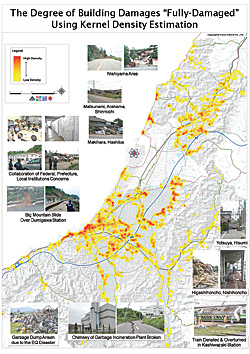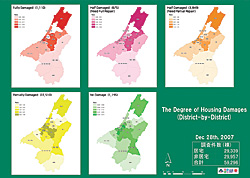ArcUser Online
During the Third Health GIS International Symposium in March 2008 in Niigata, Japan, Loma Linda University in Loma Linda, California, and Niigata University announced a five-year memorandum of understanding. This agreement will promote cooperation in education, research, and related fields with a particular focus on the advancement of health geoinformatics. It is part of Niigata University's incorporation of GIS into both research and teaching in its health and environmental programs. The two universities will share resources in technology, faculty, and students. The symposium's keynote speaker, Wendy Guan, Ph.D., director of the Center for Geographic Analysis, GIS Research Services, Harvard University, spoke on embracing geographic analysis beyond geography. Seth Wiafe, assistant professor, Loma Linda University School of Public Health, spoke on using geoinformatics for advancing public health preparedness and response through collaboration. "This collaborative agreement strongly supports the concept of creating seamless health geoinformation technology advancement that embraces the idea of preparing a competent health GIS workforce for the 21st century," said Wiafe. The agreement is part of Niigata University's pursuit of collaborative GIS training and research for health and environmental education. Located about 250 kilometers north of Tokyo on the coast of the Japan Sea in Niigata City, the university's School of Medicine offers advanced degrees in medicine and health sciences. Niigata University's charter calls for an innovative approach to education that promotes excellence, interdisciplinary and public-private collaboration, and international involvement. The university's International Academic Support Office guides the development of these goals and provides support for GIS development in the School of Medicine and School of Science. When the university started a long-term action plan to establish GIS education programs in its schools of Medicine and Science in 2005, the School of Medicine quickly established a technical laboratory; began promoting awareness of the applications of GIS in health, locally and internationally; and introduced a model of public-private collaboration for health GIS programs. The university joined the Niigata GIS Association, a local GIS user group that was started by representatives from several corporations to promote GIS literacy and data infrastructure development. Niigata Prefecture received a 2008 Esri Special Achievement in GIS Award for promoting GIS.
To make it easy for all departments to acquire GIS technology, the university purchased an Esri ArcGIS site license with all extensions in 2006 and offered an orientation seminar to introduce students to GIS and its practical applications. The same year, the School of Medicine hosted the First International Symposium on Applications of GIS in the Fields of Medicine and Public Health. The symposium sought to raise interdisciplinary, local government, and public awareness of GIS in the Niigata community. It also introduced a model for public-private collaboration in the use of GIS in health. The following year, the university established two technical instruction centers, one for human health GIS and the other for environment and disaster mitigation GIS. Courses combine selections from the Esri Virtual Campus course series with applied research work. As a result, students and researchers began using GIS in investigations of infectious disease, medical facilities usage, cancer, and suicide. International outreach programs initiated GIS epidemiology research projects in Zambia and Vietnam. At the Second International Symposium, researchers and academics from China, Korea, and Russia spoke. Conference presentations increased awareness and shared knowledge about GIS applications in health, disease control, and environmental health activities in these countries. They also encouraged discussions on how to optimize workflows such as information gathering, visualization, and evaluation. In less than three years, the school has established a health GIS teaching and research program with an international scope and a collaborative approach. In 2007, Esri presented Niigata University with the Esri Vision Award for its achievements in going beyond the traditional use of GIS within a health or human services organization. |

